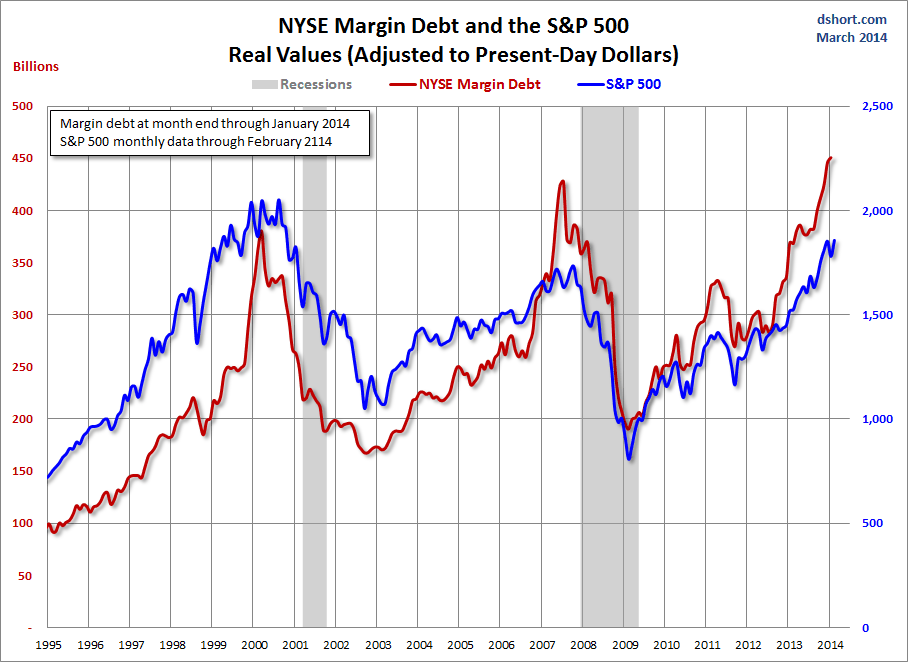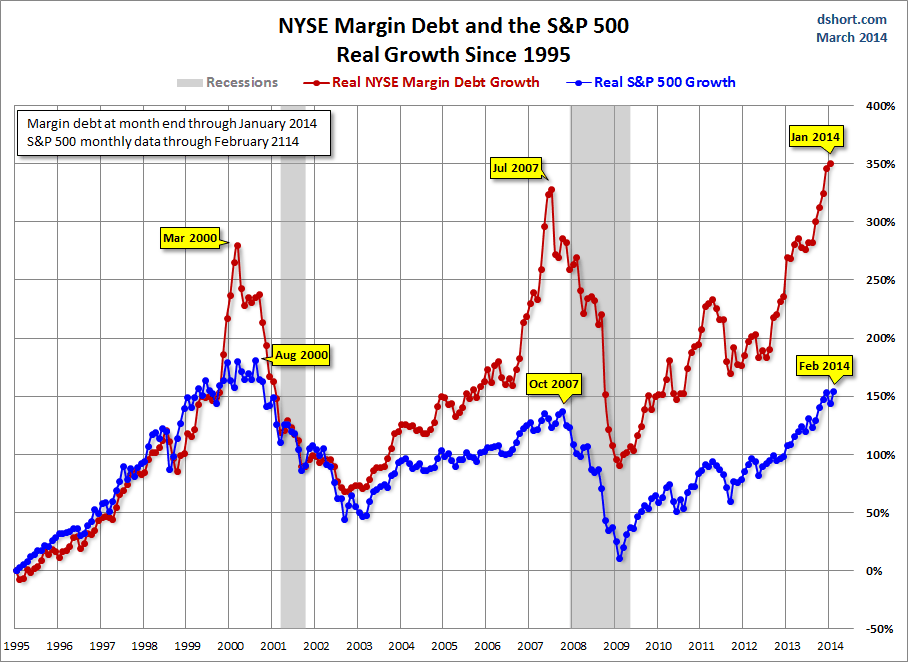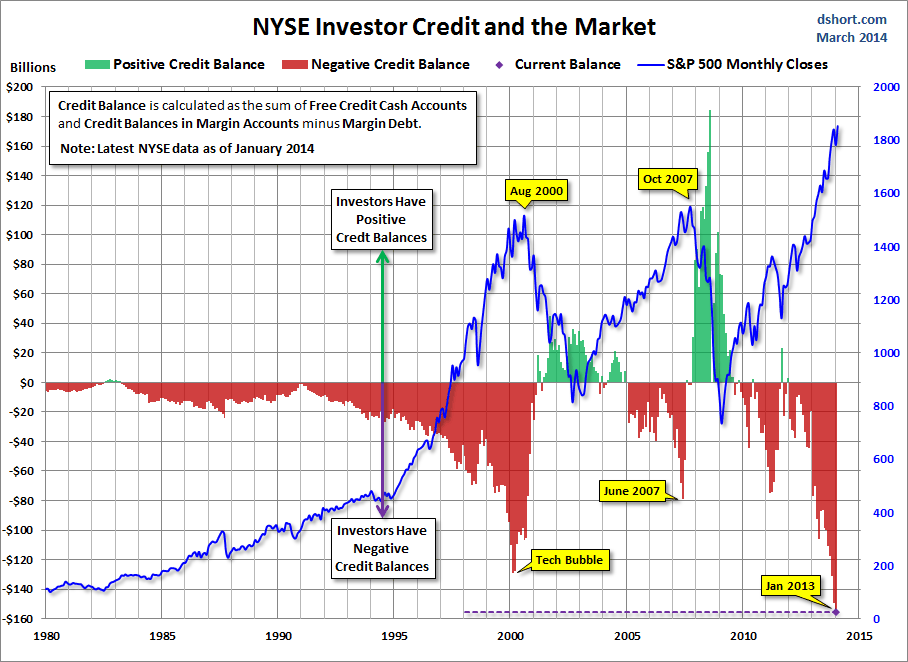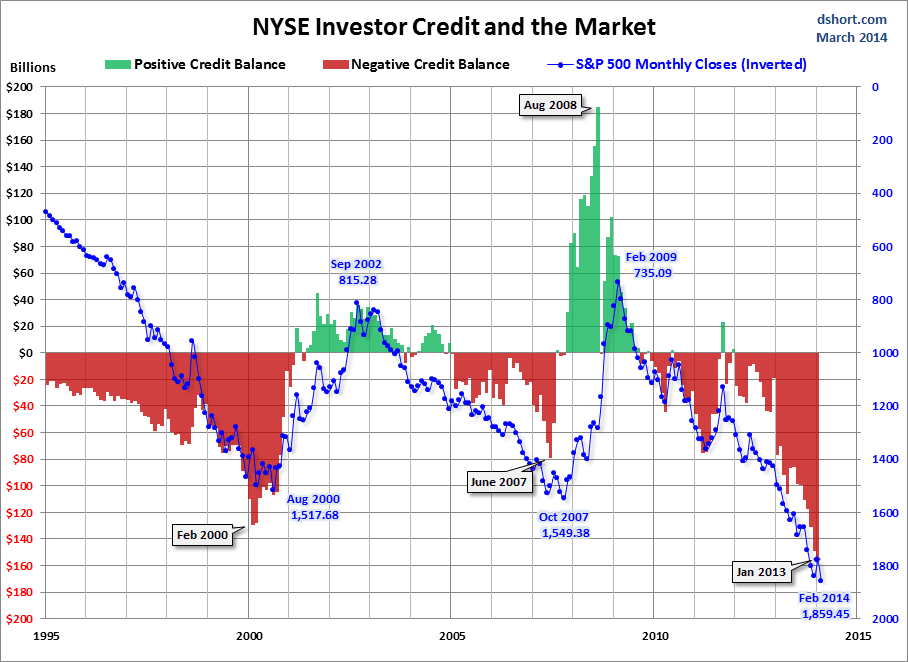The New York Stock Exchange publishes end-of-month data for margin debt on the NYXdata website, where we can also find historical data back to 1959. Let's examine the numbers and study the relationship between margin debt and the market, using the S&P 500 as the surrogate for the latter.
The first chart shows the two series in real terms — adjusted for inflation to today's dollar using the Consumer Price Index as the deflator. I picked 1995 as an arbitrary start date. We were well into the Boomer Bull Market that began in 1982 and approaching the start of the Tech Bubble that shaped investor sentiment during the second half of the decade. The astonishing surge in leverage in late 1999 peaked in March 2000, the same month that the S&P 500 hit its all-time daily high, although the highest monthly close for that year was five months later in August. A similar surge began in 2006, peaking in July 2007, three months before the market peak.
The latest data puts margin debt as at an all-time high, not only in nominal terms but also in real (inflation-adjusted) dollars.

The next chart shows the percentage growth of the two data series from the same 1995 starting date, again based on real (inflation-adjusted) data. I've added markers to show the precise monthly values and added callouts to show the month. Margin debt grew at a rate comparable to the market from 1995 to late summer of 2000 before soaring into the stratosphere. The two synchronized in their rate of contraction in early 2001. But with recovery after the Tech Crash, margin debt gradually returned to a growth rate closer to its former self in the second half of the 1990s rather than the more restrained real growth of the S&P 500. But by September of 2006, margin again went ballistic. It finally peaked in the summer of 2007, about three months before the market.

After the market low of 2009, margin debt again went on a tear until the contraction in late spring of 2010. The summer doldrums promptly ended when Chairman Bernanke hinted of more quantitative easing in his August, 2010 Jackson Hole speech. The appetite for margin instantly returned, and the Fed periodically increased the easing until the beginning of tapering purchases supposedly now underway.
The latest Margin Data
Unfortunately, the NYSE margin debt data is a few weeks old when it is published. Real margin debt at the end of January, the latest available data, had accelerated over the previous five months. If the acceleration prior to the two previous peaks offers a clue, margin debt could see some further growth.
NYSE Investor Credit
Lance Roberts, General Partner & CEO of Streettalk Advisors, analyzes margin debt in the larger context that includes free cash accounts and credit balances in margin accounts. Essentially, he calculates the Credit Balance as the sum of Free Credit Cash Accounts and Credit Balances in Margin Accounts minus Margin Debt. The chart below illustrates the mathematics of Credit Balance with an overlay of the S&P 500. Note that the chart below is based on nominal data, not adjusted for inflation.

Here's a slightly closer look at the data, starting with 1995. Also, I've inverted the S&P 500 monthly closes and used markers to pinpoint the monthly close values.

As I pointed out above, the NYSE margin debt data is a several weeks old when it is published. Thus, even though it may in theory be a leading indicator, a major shift in margin debt isn't immediately evident. Nevertheless, we see that the troughs in the monthly net credit balance preceded peaks in the monthly S&P 500 closes by six months in 2000 and four months in 2007. The most recent S&P 500 correction greater than 10% was the 19.39% selloff in 2011 from April 29th to October 3rd. Investor Credit hit a negative extreme in March 2011.
There are too few peak/trough episodes in in this overlay series to take the latest credit-balance trough as a definitive warning for U.S. equities. But we'll want to keep an eye on this metric in the months ahead.
